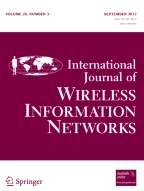Abstract
Although very developed in many sectors (databases, filesystems), access control schemes are still somewhat elusive when it comes to wireless sensor networks. However, it is clear that many WSN systems—such as healthcare and automotive ones—need a controlled access to data that sensor nodes produce, given its high sensitivity. Enforcing access control in wireless sensor networks is a particularly difficult task due to the limited computational capacity of wireless sensor nodes. In this paper we present a full-fledged access control scheme for wireless sensor data. We enforce access control through data encryption, thus embedding access control in sensor data units. We also propose a lightweight key generation mechanism, based on cryptographic hash functions, that allows for hierarchical key derivation. The suggested protocol only relies on simple operations, does not require interactions between nodes and data consumers and has minimal storage requirements.






Similar content being viewed by others
Notes
For a comprehensive view on the state of the art in the domain, the reader can refer to [16].
References
Wasp Consortium. D6.2-II Elderly Care Application: In-depth Scenarios and Use Cases, http://www.wasp-project.org/, 2007.
W. Tolone, G.-J. Ahn, T. Pai, and S.-P. Hong, Access control in collaborative systems, ACM Computing Surveys, Vol. 37, No. 1, pp. 29–41, 2005.
S. G. Akl and P. D. Taylor, Cryptographic solution to a problem of access control in a hierarchy, ACM Transactions on Computer Systems, Vol. 1, No. 3, pp. 239–248, 1983.
M.-H.-Y. Chien, Efficient time-bound hierarchical key assignment scheme, IEEE Transactions on Knowledge and Data Engineering, Vol. 16, No. 10, pp. 1301–1304, 2004.
X. Yi, Security of chien’s efficient time-bound hierarchical key assignment scheme, IEEE Transactions on Knowledge and Data Engineering, Vol. 17, No. 9, pp. 1298–1299, 2005.
W. G. Tzeng, A time-bound cryptographic key assignment scheme for access control in a hierarchy, IEEE Transactions on Knowledge and Data Engineering, Vol. 14, No. 1, pp. 182–188, 2002.
M. Shehab, E. Bertino, and A. Ghafoor, Efficient hierarchical key generation and key diffusion for sensor networks. In Second Annual IEEE Communications Society Conference on Sensor and AdHoc Communications and Networks, 2005.
M. J. Atallah, M. Blanton, and K. B. Frikken, Incorporating temporal capabilities in existing key management schemes. In ESORICS, pp. 515–530, 2007.
M. J. Atallah, M. Blanton, and K. B. Frikken, Incorporating temporal capabilities in existing key management schemes. Cryptology ePrint Archive, Report 2007/245, 2007.
M. Bellare, R. Canetti, and H. Krawczyk, Keying hash functions for message authentication. In CRYPTO, pp. 1–15, 1996.
J.-O. Mauborgne and G. Vernam, One Time Pad Scheme. http://en.wikipedia.org/wiki/One-time pad.
A. Fiat and M. Naor, Broadcast encryption. In CRYPTO, pp. 480–491, 1993.
S.-M. Chang, S. Shieh, W. W. Lin, and C.-M. Hsieh, An efficient broadcast authentication scheme in wireless sensor networks. In ASIACCS ’06: Proceedings of the 2006 ACM Symposium on Information, Computer and Communications Security, pp. 311–320, New York, NY, USA, 2006. ACM.
M. Mathews, M. Song, S. Shetty, and R. McKenzie, Detecting compromised nodes in wireless sensor networks. In SNPD ’07: Proceedings of the Eighth ACIS International Conference on Software Engineering, Artificial Intelligence, Networking, and Parallel/Distributed Computing (SNPD 2007), pp. 273–278, Washington, DC, USA, 2007. IEEE Computer Society.
T. Li, M. Song, and M. Alam, Compromised sensor nodes detection: a quantitative approach. In ICDCSW, pp. 352–357, 2008.
A. Perrig and J. D. Tygar, Secure Broadcast Communication in Wired and Wireless Networks. Kluwer Academic Publishers, Norwell, MA, USA, 2002.
M. Bellare and P. Rogaway, Random oracles are practical: a paradigm for designing efficient protocols. In ACM Conference on Computer and Communications Security, pp. 62–73, 1993.
M. Bellare, A. Desai, E. Jokipii, and P. Rogaway. A concrete security treatment of symmetric encryption. In FOCS ’97: Proceedings of the 38th Annual Symposium on Foundations of Computer Science (FOCS ’97), Washington, DC, USA, p. 394, 1997. IEEE Computer Society.
H. Dobbertin, A. Bosselaers, and B. Preneel, RIPEMD-160: a strengthened version of RIPEMD. In Fast Software Encryption, pp. 71–82, 1996.
A. Rukhin, J. Soto, J. Nechvatal, M. Smid, E. Barker, S. Leigh, M. Levenson, M. Vangel, D. Banks, A. Heckert, J. Dray, and S. Vo, A Statistical Test Suite for Random and Pseudorandom Number Generators for Cryptographic Applications. NIST special publication 800-22, National Institute of Standards and Technology (NIST), Gaithersburg, MD, USA, 2001.
NIST 800-22b, Download Documentation and Software for the Nist 800-22b, special publication.
G. Masaglia, The Marsaglia Random Number Cdrom Including the Diehard Battery of Tests of Randomness, 1995.
S. Kim, K. Umeno, and A. Hasegawa, Corrections of the NIST Statistical Test Suite for Randomness, 2004.
A. J. Menezes, S. A. Vanstone, and P. C. Van Oorschot, Handbook of Applied Cryptography. CRC Press, Inc., Boca Raton, FL, USA, 1996.
L. Blum, M. Blum, and M. Shub, A simple unpredictable pseudo-random number generator, SIAM Journal on Computing, Vol. 15, No. 2, pp. 364–383, 1986.
N. Ferguson and B. Schneier, Practical Cryptography, Wiley, New York, NY, USA, 2003.
Author information
Authors and Affiliations
Corresponding author
Rights and permissions
About this article
Cite this article
Sorniotti, A., Molva, R., Gomez, L. et al. Efficient Access Control for Wireless Sensor Data. Int J Wireless Inf Networks 16, 165–174 (2009). https://doi.org/10.1007/s10776-009-0102-4
Published:
Issue Date:
DOI: https://doi.org/10.1007/s10776-009-0102-4
